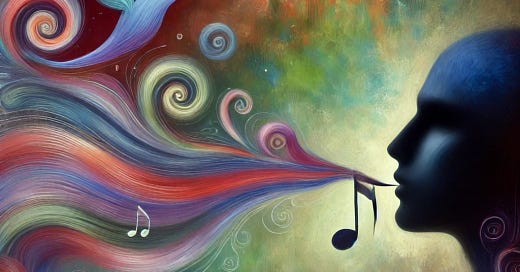Voice-over provided by Amazon Polly
Also, check out Eleven Labs, which we use for all our fiction.
Introduction
Whistling is one of the simplest yet most intriguing forms of sound production that humans and animals use for various purposes. Though often dismissed as a casual pastime or a spontaneous act, whistling has a deep and rich history that spans cultures and centuries. It is an expressive tool, allowing individuals to communicate emotions, signals, and messages in ways that transcend spoken language.
From a young age, many people learn to whistle as a form of amusement, yet in many societies, it has developed into an essential means of communication. Whether echoing through the canyons of the Canary Islands, signaling commands among shepherds in the mountains of Turkey, or carrying melodies in bustling city streets, whistling has been adapted to fit the needs of different communities. Beyond its practical uses, whistling also plays an integral role in artistic expression, appearing in music, film, and even competitive events.
Interestingly, whistling is not just a human phenomenon; many species of birds, dolphins, and even some primates use whistling-like sounds for social interaction, mating calls, and territorial signals. This parallel between human and animal whistling highlights its evolutionary significance as a fundamental aspect of communication.
This article delves into the multifaceted role of whistling, exploring its influence on entertainment, linguistic traditions, and even interspecies communication, shedding light on a skill that is both ancient and ever-evolving.
Whistling in Music: From Street Corners to Concert Halls
Whistling has played a prominent role in music for centuries, evolving from simple tunes to a refined artistic expression. From street performers to celebrated musicians, whistling has served as a distinctive and engaging sound in multiple musical genres. Whether used for improvisation, harmonization, or storytelling, whistling has carved out a unique niche in the world of music.
Classical and Folk Music
In classical music, whistling has been utilized as both a solo and ensemble instrument. Composers like Wolfgang Amadeus Mozart and Camille Saint-Saëns incorporated whistling melodies into their compositions. Additionally, folk traditions around the world have embraced whistling as a means of adding melody and rhythm to their music, particularly in cultures where vocalization is emphasized over instrumentation.
In certain regions, whistling is an integral part of traditional performances. In the Appalachian folk tradition, for example, whistling often complements string instruments like the banjo or fiddle. In Andean music, whistling is used to imitate the sounds of the pan flute, creating a deeply resonant and haunting effect. In some African and Asian cultures, whistling serves a spiritual or ceremonial function, connecting musicians to ancestral traditions.
Pop Culture and Hollywood
Whistling has become an iconic element in popular music and film scores. Some of the most memorable movie soundtracks, such as Ennio Morricone’s themes for spaghetti Westerns (e.g., The Good, the Bad, and the Ugly), heavily feature whistling. Beyond film, pop songs like Otis Redding’s "(Sittin’ On) The Dock of the Bay" and Peter Bjorn and John’s "Young Folks" highlight how a catchy whistle can make a song instantly recognizable.
In television, animated series and classic sitcoms have used whistling to craft memorable theme songs, such as The Andy Griffith Show, where the opening theme is an unmistakable whistle melody. Even video games have incorporated whistling into their soundtracks, with titles like The Legend of Zelda: Ocarina of Time featuring whistled tunes as part of their musical landscape.
Competitive Whistling
Competitive whistling is a niche yet passionate community where skilled individuals display their abilities in international contests. The World Whistling Championship, held annually, celebrates virtuosos who master classical and contemporary whistling styles. Contestants are judged on tone, pitch control, and musicality, proving that whistling can be an art form on par with any instrumental performance.
Beyond formal competitions, whistling duels and exhibitions occur in cultural festivals worldwide. In places like Spain and Brazil, whistlers showcase intricate melodies and even battle in friendly rivalries, where participants must match and outdo each other’s whistled improvisations. Some modern musicians, such as whistling virtuoso Geert Chatrou, have elevated whistling to a professional level, demonstrating that this art form is as complex and expressive as any other musical discipline.
Additionally, social media has played a role in reviving interest in whistling. Viral videos featuring impressive whistling performances have introduced younger generations to the craft, encouraging new talent to emerge and participate in global competitions. Some performers even incorporate whistling into loop stations, layering whistled harmonies to create full compositions without traditional instruments.
Whistling is more than just a simple tune hummed absentmindedly—it is a musical force that continues to captivate audiences and inspire innovation in the modern music scene.
Whistling as a Coded Language
Beyond its musical applications, whistling has served as a practical communication tool in many cultures. Whistled languages, developed in remote or mountainous areas, allow for long-distance conversation where speech alone would not suffice.
Whistled Languages Around the World
Silbo Gomero (Canary Islands, Spain): This UNESCO-recognized whistled language, spoken by the inhabitants of La Gomera, replicates Spanish phonetics and enables conversations across vast valleys.
Mazatec Whistling (Mexico): Used by the indigenous Mazatec people, this language conveys complex messages and is particularly useful in rugged terrains.
Kuşköy (Turkey): Often referred to as "bird language," this whistled communication system is still practiced in the Black Sea region and has been taught in schools to preserve its heritage.
Pirahã Whistling (Brazil): Among the Pirahã people of the Amazon, whistling is used as an extension of their tonal language, allowing them to communicate over the dense jungle landscape.
Aas Whistling (India): In some rural communities in India, whistling is used to call out messages across large fields, often for agricultural coordination.
Each of these languages utilizes tone and pitch variations to replace spoken words, illustrating how human ingenuity has harnessed whistling for linguistic innovation.
Military and Covert Communication
Historically, whistling has also played a role in covert operations. During World War II, spies and resistance fighters used whistled tunes as coded signals to convey secret messages without arousing suspicion. Similarly, certain tribal communities have used whistling to coordinate hunting efforts and relay danger warnings.
In modern times, law enforcement and military units have been known to use whistled signals during training exercises and field operations, particularly in situations requiring silent communication. Additionally, some urban communities have adopted unique whistled signals for safety alerts, neighborhood warnings, or even gang-related communication, demonstrating how whistling continues to serve as a discreet but effective form of messaging.
Whistling and Bird Communication
Whistling creates a fascinating bridge between humans and birds, as both species use similar sound mechanics for communication.
Mimicry and Mutual Interaction
Many bird species, such as parrots and lyrebirds, can imitate human whistles. In return, skilled human whistlers can mimic bird calls, establishing an interactive relationship. Birdwatchers and ornithologists often use specific whistles to attract birds or study their behavior.
Whistling in Hunting and Conservation
Some indigenous groups use whistling techniques to lure birds during hunting, a practice that dates back thousands of years. However, in the modern era, these same techniques are also employed for conservation efforts, such as using recorded whistles to guide endangered birds back to safe habitats.
Music Inspired by Bird Whistling
Many composers have drawn inspiration from bird songs, incorporating whistling motifs into classical and folk compositions.
The Psychology of Whistling: Why Do We Whistle?
Whistling is often associated with particular emotional states, whether as an expression of joy, focus, or even nervousness. The reasons why people whistle are deeply rooted in both psychological and cultural factors, often reflecting their mental state, social environment, and personal habits.
Whistling as a Stress Reliever: Studies suggest that whistling can act as a form of stress relief, similar to controlled breathing techniques. The act of whistling regulates airflow and can have a calming effect. Many individuals unconsciously whistle when they are nervous, using the steady rhythm as a coping mechanism to manage anxiety. Some psychologists compare whistling to humming, noting that both activities can trigger the release of endorphins and promote relaxation. Additionally, structured breathing patterns associated with whistling help regulate oxygen intake, which may contribute to reduced stress levels.
Whistling and Concentration: Many people whistle while working or engaging in repetitive tasks. This is particularly common in trades like carpentry, painting, or factory work, where the rhythm of a whistle can help maintain focus and productivity. The repetitive motion of whistling, much like tapping a foot or drumming fingers, can create a metronomic effect that enhances concentration. Some studies have even suggested that whistling may stimulate brain activity, improving problem-solving skills and cognitive flexibility. Professional chess players, for example, have been observed to whistle softly during deep thought, reinforcing the idea that the act can enhance mental clarity.
Whistling as a Mood Enhancer: Beyond stress relief, whistling is often associated with feelings of joy and contentment. People frequently whistle when they are in a good mood, using it as a spontaneous expression of happiness. This phenomenon has been noted in various professions, from postmen and barbers to artists and musicians, where whistling serves as an auditory sign of a relaxed and engaged state of mind.
Social and Cultural Taboos: While whistling is widely accepted in many cultures, some societies consider it inappropriate. In Russia, for instance, whistling indoors is believed to bring financial misfortune, as it is thought to "whistle away" one's wealth. In some African traditions, whistling at night is thought to summon spirits or bring misfortune. Similarly, in Japan, nighttime whistling is discouraged because of the belief that it attracts thieves or supernatural beings. These cultural taboos highlight the symbolic power that whistling holds beyond its basic function as a sound.
The Future of Whistling
Despite advances in technology, whistling remains relevant in modern society. Whether in the form of street performances, musical innovation, or cultural preservation efforts, the practice continues to thrive. With the resurgence of interest in organic, human-driven art forms, whistling may even experience a new wave of appreciation in the digital age.
In recent years, there has been a growing fascination with traditional, non-digital art forms, from hand-lettering to acoustic performances. As part of this revival, whistling has seen renewed interest through social media, where viral videos of skilled whistlers have garnered millions of views. Online platforms have given rise to modern-day whistling influencers who demonstrate intricate techniques, ranging from bird call imitations to full-scale musical compositions.
Moreover, researchers continue to explore the cognitive and physiological benefits of whistling. Studies suggest that learning to whistle can improve breath control, lung capacity, and even mental focus, making it a valuable practice for musicians, athletes, and those engaged in mindfulness techniques. Some vocal coaches incorporate whistling exercises into their training programs to help singers develop better breath support and pitch control.
In the realm of performance arts, whistling has expanded beyond its traditional uses in film and music. Theatrical productions and live performances have incorporated whistling as a unique storytelling element, adding a layer of expression that transcends language barriers. Some modern dance and movement artists integrate whistling into their routines, using it to synchronize choreography or convey emotion through sound.
As an art, a language, and a bridge to nature, whistling is far more than just a simple sound. It is a deeply rooted tradition that connects people across cultures and generations, proving that even the most basic human expressions can carry extraordinary significance. Whether as a form of creative expression, a meditative practice, or a historical artifact preserved for future generations, whistling is poised to remain an enduring and cherished skill in the years to come.
Thank you for your time today. Until next time, be bold.
Do you like what you read but aren’t yet ready or able to get a paid subscription? Then consider a one-time tip at:
https://www.venmo.com/u/TheCogitatingCeviche
Ko-fi.com/thecogitatingceviche








